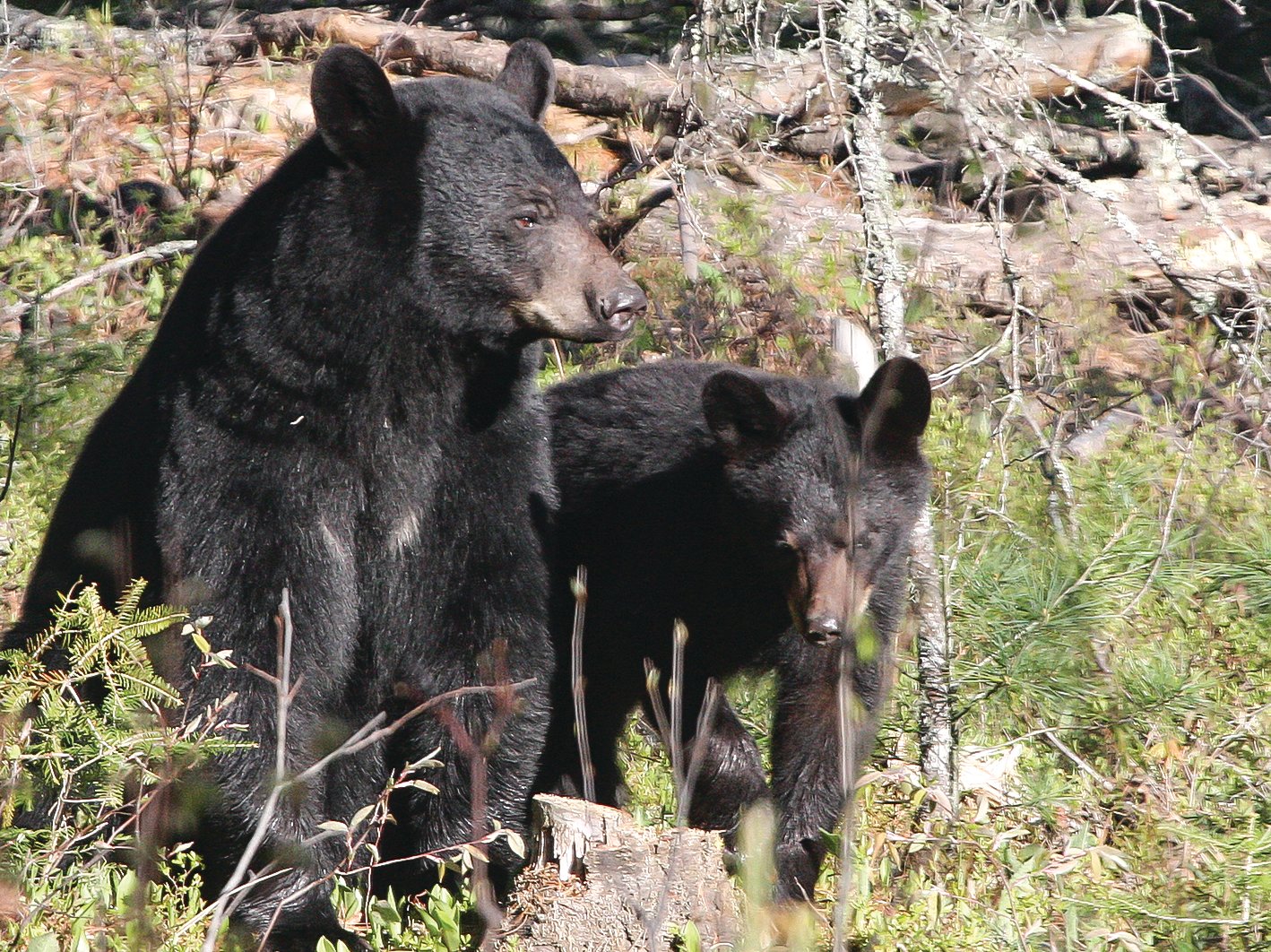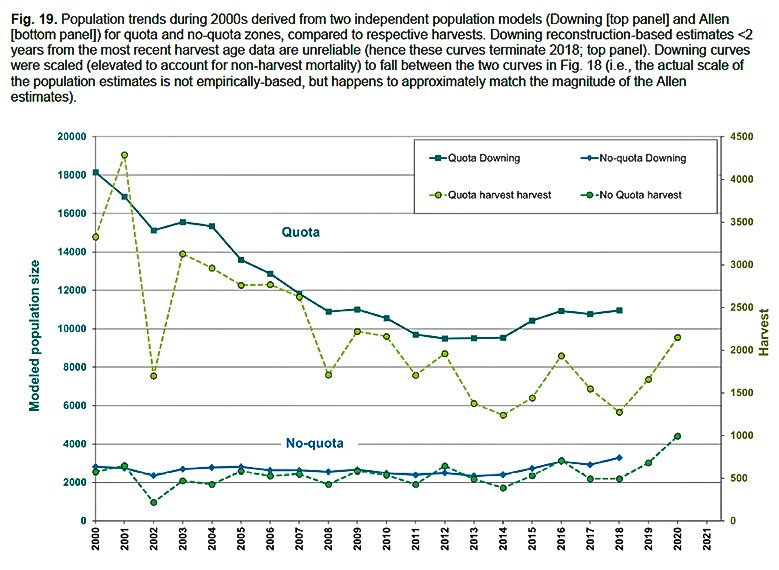Support the Timberjay by making a donation.
Do bears need a break?
High hunter harvests may be be holding back recovery of the region’s black bear population
As I’ve written here before, there is reason to be concerned about the status of the black bear population here in the North Country, in part because the population here on the Canadian Shield …
This item is available in full to subscribers.
Attention subscribers
To continue reading, you will need to either log in to your subscriber account, or purchase a new subscription.
If you are a current print subscriber, you can set up a free website account and connect your subscription to it by clicking here.
If you are a digital subscriber with an active, online-only subscription then you already have an account here. Just reset your password if you've not yet logged in to your account on this new site.
Otherwise, click here to view your options for subscribing.
Please log in to continue |
Do bears need a break?
High hunter harvests may be be holding back recovery of the region’s black bear population
As I’ve written here before, there is reason to be concerned about the status of the black bear population here in the North Country, in part because the population here on the Canadian Shield isn’t like the population found elsewhere in Minnesota.
It’s obvious that the ability of a bear population, or any wildlife population, to sustain a given level of human hunting mortality is dependent on the ability of that species to replace those elements of the population lost to hunting or other sources of mortality each year. As top predators, bears have evolved for a very slow rate of reproduction, in order to prevent them from outstripping their habitat’s carrying capacity. In fact, bears exhibit some of the lowest reproductive rates of any terrestrial mammals, which means their ability to bounce back from downturns to their population is limited.
For bears, hunter harvest is the primary form of mortality. As a substantial body of scientific literature has documented, the ability of black bears to sustain themselves in the face of human harvest is limited, and is highly dependent on available foods. It’s long been known that bear populations on the Shield have more limited reproductive potential due to limited foods compared to more productive areas to our south. Many of the most favored bear foods found elsewhere in the eastern half of North America are rare or non-existent here and that impacts bears in several ways.
A 1981 study by two Canadian biologists, Fred Bunnel and David Tait, is still widely acknowledged to be among the most authoritative studies on bear population dynamics and it is worth reading by anyone with an interest in the subject. The study finds that the reproductive capacity of black bear populations is highly connected to their nutritional condition. Bears that have access to abundant food reach breeding age earlier, have large litters and more frequent litters. According to Bunnel and Tait, bears in quality habitat, such as is typical in central Minnesota or much of the northeastern U.S., can sustain a higher level of harvest. That’s because bears there reach sexual maturity at an average of 4.5 years, give birth on an average of once every 2.1 years, and have an average litter size of 3.1 cubs. Based on such criteria, bears can sustain an annual mortality rate of approaching 20 percent. But that number drops significantly in locations, like far northeastern Minnesota, where natural bear foods are scarcer. Up here, bears without frequent access to human sources of food don’t reach breeding age until age five or six, they have smaller litters, and their litters are more widely spaced.
Black bear populations with these characteristics can sustain much lower levels of harvest, only about 13-15 percent according to Bunnel and Tait, and that assumes average conditions.
According to Andrew Tri, one of the DNR’s top bear researchers, the current harvest level in the quota zone, which includes a large swath of central, northcentral, and northeastern Minnesota, is running around 15 percent, although DNR data suggests that percentage has averaged closer to 18 percent the past three seasons (see the chart above). Even at 15 percent, it’s distinctly on the high side of what is sustainable for bear populations in our area, and it certainly is not a recipe for bear population recovery, which is currently one of the DNR’s goals, at least publicly.
The DNR is supposed to be managing for bear recovery in large part due to prior DNR management decisions, which cut the state’s bear population nearly in half between 2000 and 2010. Back then, the DNR was issuing around 20,000 permits a year and annual harvests were averaging about 3,500 animals, most of that in the quota zone. Back in 2000, the DNR, using a variety of models, estimated the state’s bear population at between 20,000 and 25,000 animals. After a decade of high harvest, the state’s bear population had fallen to between 10,000-15,000.
The DNR slashed the number of bear permits dramatically beginning in 2012 in an effort to reverse course, but progress toward a recovery has been very slow, and has very likely gone backward in the past couple years, when poor bear foods led to harvests close to what we saw back in the 2000s.
It should be noted that more of the state’s harvest is now coming from the state’s no-quota zone, which includes those parts of the state to the south and west of the quota zone, where bears are more of a management problem due to the presence of agriculture and greater incidence of human conflict in general. As permit availability, now around 3,500, plummeted in the quota zone, making permits much more difficult to obtain, more hunters have opted to try their luck elsewhere. The reduction in permits in the quota zone has led to a lower bear harvest to be sure, but nowhere near the reduction that might be expected given that permits were slashed from 20,000 to under 4,000. Bear hunter success rates have gone up as well, and that’s limited the beneficial impact of lower permit numbers. It’s also worth noting that hunters are now taking bears from a population that is much reduced. If you take 3,000 animals from a population of 20,000 bears, it’s the same in percentage terms as taking 1,500 bears from a population of 10,000.
Because wildlife population modeling is inexact, and because the DNR doesn’t model by bear management area, we don’t know if there’s been any recovery of bear numbers in management areas 25 and 31, which, combined, encompass virtually all of the Shield country in Minnesota that sees any appreciable numbers of hunters. But there’s reason to believe that the harvest may still be outstripping the ability of the population to maintain itself here. Indeed, DNR officials acknowledge as much.
The situation today is probably even worse than we know. Given the recent trend of poorer food years, it’s not clear that the bear population on Minnesota’s Shield country can sustain much of a bear harvest at all. In years of successive poor foods, like we’ve seen in recent years, research from Montana suggests that black bear reproduction can fall to near zero. Research in Minnesota finds a similar pattern. Bears are among a number of species that have evolved with delayed implantation of embryos. They breed in the late spring or early summer, but the fertilized eggs don’t implant in a female bear’s womb until November or December. If the female didn’t put on enough weight during the previous summer, those eggs simply don’t implant.
Bear reproduction has likely fallen off sharply in our region during the past two years, and this coincides with some of the highest bear harvests we’ve had since the DNR reduced the permits. That’s one of the problems with managing black bear populations, particularly for recovery. It isn’t easy. When foods are scarce, bears are more susceptible to hunters’ baits, so that means the harvest goes up at a time when reproduction is likely going to fall. In years of repeated poor foods, such as we’ve seen recently, the problem compounds.
And climate change may be a factor, here. We’ve seen a significant trend of more extreme temperature swings and greater variability in precipitation and it’s those extremes that have been impacting wild foods in our area. Early spring green-ups, followed by killing frosts in June, can wipe out berry crops. Droughts impact virtually everything. These are factors that have impacted natural foods the past 2-3 years and have undoubtedly affected bear reproduction. If the DNR isn’t reducing its permits to respond, the agency is putting the region’s bear population at even greater risk. The other alternative would be to prohibit or greatly restrict bear baiting in management areas where bears are struggling. That’s not as outlandish as it might sound. Twenty-eight states in the U.S. have bear seasons, and only 11, including Minnesota, allow hunting directly over baits. We’ve gotten used to the practice here, because it’s easy for hunters, but in most places it’s not allowed. And a few bear hunters in Minnesota don’t rely on baits even today.
While the DNR focuses much of its attention on hunters, there are other people out there who actually like to see bears in the wild. I’m one of them, and I know I see a lot fewer bears than I used to. How do the DNR’s black bear management efforts meet the wishes of folks who’d like to see a few more bears out there in the woods? Not very well it would seem.









